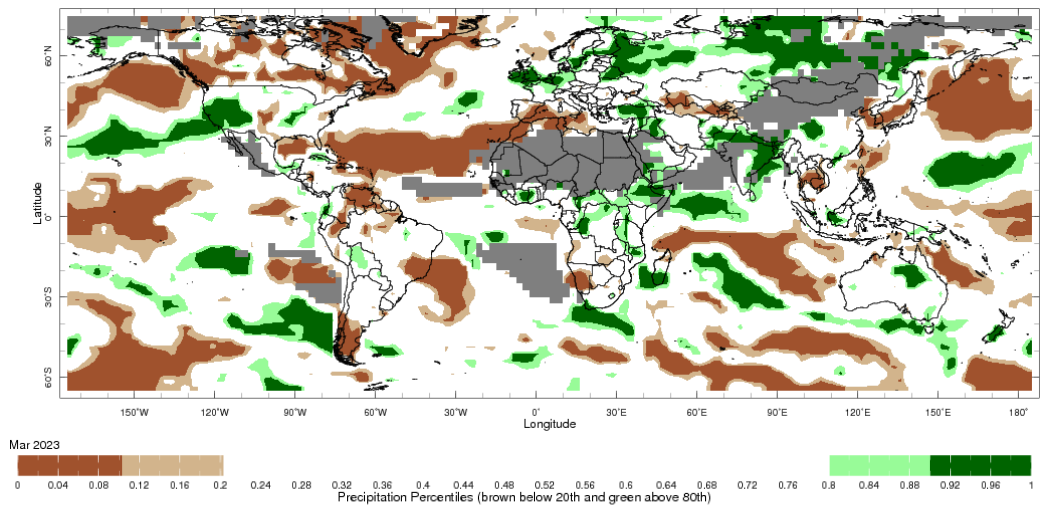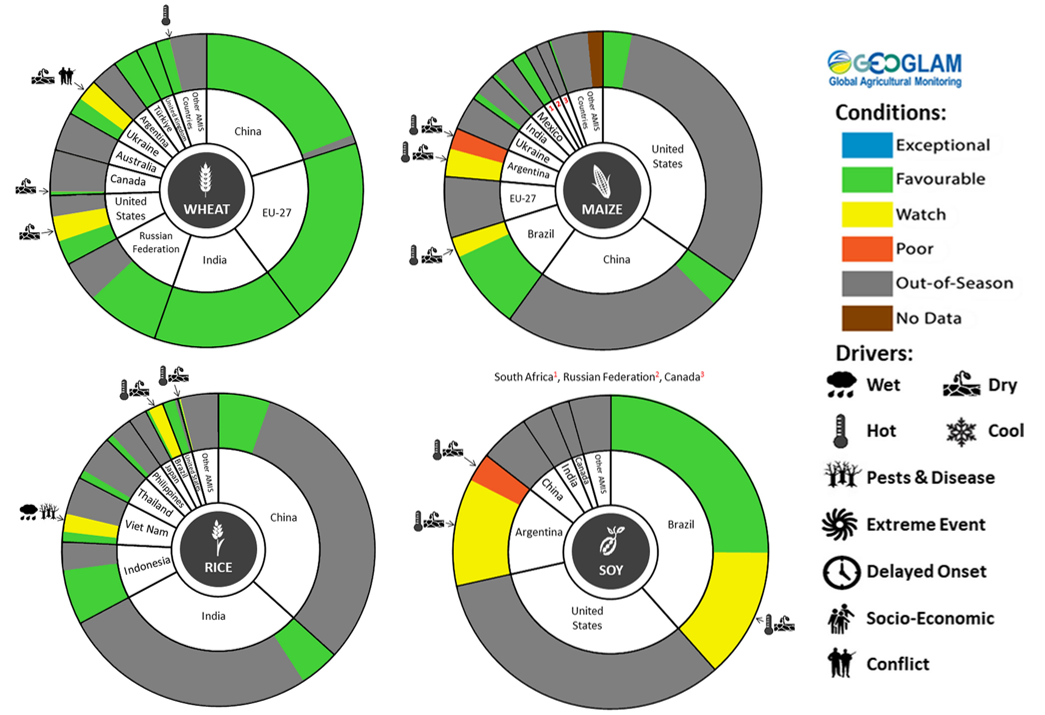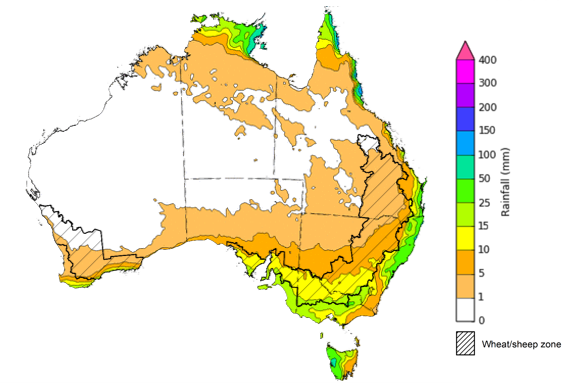Key issues
- For the week ending 19 April 2023, severe Tropical Cyclone (TC) Ilsa brought heavy rainfall across remote areas of central Australia with higher totals near the Pilbara coast in Western Australia. The remnants of TC Ilsa combined with a cold front, leading to heavy rainfall also being recorded across south-eastern Australia. Troughs in the tropical north resulted in rainfall across the Northern Territory’s Top End and the Cape York Peninsula in Queensland.
- In cropping regions, rainfall totals of between 15 and 50 millimetres were recorded across eastern Western Australia, northern Queensland, southern New South Wales, much of Victoria, and western and central South Australia. Little to no rainfall was recorded across the remaining cropping regions over the past 7 days (see Section 1.1).
- Average to below average rainfall globally during March is likely to result in lower-than-expected winter wheat production potential in the United States and Ukraine. In contrast, improved growing conditions across northern hemisphere is expected to raise spring wheat production prospects in a number of key production regions. Below average rainfall during March has also negatively affected corn and soybean production across Argentina and southern Brazil. This is providing a deterioration in global production conditions compared to those seen back in March 2023, that were used to formulate ABARES forecasts of global grain supplies and the impact on world prices in its March 2023 edition of Agricultural commodities. As a result, global coarse grain and oilseed production is likely to be lower than that forecast in March (see Section 1.2).
- Over the 8-days to 27 April 2023, a high-pressure system is expected to keep much of the country generally dry. A trough in the north will trigger storms across the Top End and northern Queensland. Meanwhile, cool onshore winds are expected to bring showers over eastern New South Wales and southeast Queensland. A trough and front crossing southeast Australia should bring showers over Victoria, southeast South Australia and western Tasmania (see Section 1.3).
- Across Australian cropping regions, rainfall totals of up to between 10 and 25 millimetres are expected for southern New South Wales, and much of Victoria and South Australia in the next eight days. Little to no rainfall is expected for the remaining cropping regions. For those area of the Australian wheatbelt where rainfall is expected, it is likely to continue to build soil moisture levels in the led up to the winter cropping season and also benefit pasture growth rates and availability. Dry conditions elsewhere would allow harvest and planting activities to progress (see Section 1.3).
- storage levels in the Murray-Darling Basin (MDB) remained steady at 89 percent of total of capacity between 13 April 2023 and 20 April 2023. Current volume of water held in storage is 19 956 GL. This is 2 percent or 306 GL more than at the same time last year.
- Allocation prices in the Victorian Murray below the Barmah Choke decreased from $13 on 13 April 2023 to $11 on 20 April 2023. Prices are lower in the Murrumbidgee and regions above the Barmah choke due to the binding of the Murrumbidgee export limit and Barmah choke trade constraint.
Climate
For the week ending 19 April 2023, severe Tropical Cyclone (TC) Ilsa brought heavy rainfall across remote areas of central Australia with higher totals near the Pilbara coast in Western Australia. The remnants of TC Ilsa combined with a cold front, leading to heavy rainfall also being recorded across south-eastern Australia. Troughs in the tropical north resulted in rainfall across the Northern Territory Top End and the Cape York Peninsula in Queensland.
Weekly rainfall totals greater than 25 millimetres were recorded across central, northern and southwestern Western Australia, much of the Northern Territory and South Australia, Victoria, Tasmania, parts of southern New South Wales, and isolated parts of northeast and much of northern Queensland. Rainfall in excess of 100 millimetres were recorded in the Pilbara region of Western Australia and western Northern Territory. Dry conditions were recorded elsewhere.
In cropping regions, rainfall totals of between 15 and 50 millimetres were recorded across south eastern Western Australia, northern Queensland, southern New South Wales, much of Victoria, and western and central South Australia. Little to no rainfall was recorded across the remaining cropping regions over the past 7 days.
Clear, dry conditions over the past week have reportedly allowed the cotton harvesting in Central Queensland to continue without delay. In southern New South Wales, rice harvesting is well under way, with above average yields being recorded. Although there are areas of summer crop yet to harvest, recent rainfalls across eastern and western cropping regions are providing ideal soil moisture conditions to start the winter cropping season. Many regions have received sufficient rainfall to classify as an autumn break, and planting activity is likely to increase over the coming weeks.
Rainfall for the week ending 19 April 2023
Note: The rainfall analyses and associated maps utilise data contained in the Bureau of Meteorology climate database, the Australian Data Archive for Meteorology (ADAM). The analyses are initially produced automatically from real-time data with limited quality control. They are intended to provide a general overview of rainfall across Australia as quickly as possible after the observations are received. For further information go to http://www.bom.gov.au/climate/rainfall/
Crop production is affected by long-term trends in average rainfall and temperature, interannual climate variability, shocks during specific growth stages, and extreme weather events. Some crops are more tolerant than others to certain types of stresses, and at each growth stage, different types of stresses affect each crop species in different ways. The precipitation anomalies and outlooks presented here give an indication of the current and future state of production conditions for the major grain and oilseed producing countries which are responsible for over 80% of global production. This is an important input to assessing the global grain supply outlook.
March precipitation percentiles and current production conditions
As of the end of March 2023, rainfall was mixed for the world’s major grain-producing and oilseed-producing regions.
In the northern hemisphere, precipitation was below average in central and southern United States, much of Canada and Southeast Asia. Precipitation was above average for western and eastern United States, much of United Kingdom and Türkiye, northern and eastern India and the Russian Federation, central and south-eastern China and northern Europe. Precipitation was close to average across the remainder of the major grain-producing and oilseed-producing regions in the northern hemisphere.
In the southern hemisphere, March precipitation was below average in southern Argentina and parts of northern Brazil. Precipitation was above average for a localised area of central Brazil, and south-eastern Australia. Precipitation was close to average across the remainder of major grain-producing and oilseed-producing regions in the southern hemisphere.
Global precipitation percentiles, March 2023
Source: International Research Institute for Climate and Society
As of 6 April 2023 global production conditions were mixed for the production of wheat, corn, rice and soybean.
In the northern hemisphere production conditions for wheat have been generally favourable, except for the United States and Ukraine where it has been mixed. The conflict in Ukraine is continuing to restrict access to inputs and limit field access, which has generated additional levels of uncertainty for the wheat production outlook.
Conditions for corn in Argentina for early- and late-planted crop development are below average to poor due to drought and high temperatures affecting yield potential. In Brazil, harvest is ongoing for the spring-planted crop (smaller season) under generally favourable conditions, except in Rio Grande do Sul where hot and dry conditions during reproductive stages have negatively impacted yields for spring-planted crops in the south. The sowing of summer-planted corn is drawing to a close with favourable growing conditions expected. Likewise, sowing of corn in China and south-eastern United States has started under favourable conditions. In India, Mexico and South Africa, conditions were generally favourable for crop development.
Transplanting of Rabi rice in India has finished under favourable conditions. Harvesting of wet-season rice continues following favourable seasonal conditions, resulting in above average yields. Sowing of early-season rice is underway in China with favourable conditions. In the Philippines and Thailand, harvesting of dry-season rice is ongoing under favourable conditions. Winter-spring rice in northern Vietnam is in early vegetative growth stages under favourable conditions, while harvesting is underway in the south under mixed conditions. In Brazil, harvesting is underway with dry conditions during reproductive stages having reduced yields in the south.
Harvesting of early-sown soybean is underway in Argentina with reduced yield potentials due to prolonged periods of hot, dry conditions having negatively impacted the crop in concentrated planted areas. In Brazil, drought conditions and high temperatures in southern regions during reproductive stages have negatively impacted yield potential. However, in other regions, harvesting continues under favourable conditions.
Crop conditions, AMIS countries, 6 April 2023
Source: AMIS
The global climate outlook for May 2023 to July 2023 indicates that mixed rainfall conditions are expected for the world's major grain-producing and oilseed-producing regions. Outlooks and potential production impacts for the major grain and oilseed producing countries are presented in the table.
Rainfall outlook and potential impact on the future state of production conditions between May 2023 to July 2023
| Region | May-July rainfall outlook | Potential impact on production |
|---|---|---|
| Argentina | Average to above average rainfall across the north, below average rainfall in the east and average rainfall elsewhere is likely. | Above average rainfall may interrupt the harvesting of sorghum, rice, millet, soybeans, corn, sunflower, cotton and nuts. However, the dry conditions are likely to negatively impact the germination and establishment of wheat. |
| Black Sea Region | Average to above average rainfall is forecast for most of Türkiye and the Russian Federation. Below average rainfall is likely for southern Kazakhstan and average rainfall for the remaining Kazakhstan. | Below average rainfall in southern Kazakhstan may adversely affect grain filling of wheat and canola, as well as cotton, corn and sunflower from July 2023. Average rainfall across much of Türkiye and the Russian Federation is likely to support similar crops in the south and the heading of spring wheat in the north from June 2023. |
| Brazil | Above average rainfall is more likely across central and western Brazil and below average rainfall is more likely in the isolated parts of southern, eastern and much of north-eastern Brazil. | Above average rainfall across central and western Brazil may interrupt the harvesting of cotton and corn. Below average rainfall in the south is likely to impede the germination and establishment of wheat in June and July 2023. |
| Canada | Average rainfall is forecast for much of Canada, while below average rainfall is more likely in the isolated part of central and western Canada. | Above average rainfall is likely to positively impact yield potentials of winter wheat as they enter critical reproductive phases from July 2023, as well as the growth and development of corn, soybeans and sunflower. |
| China | Average to above average rainfall is more likely across much of China while below average rainfall is more likely across isolated parts of western China. | Above average rainfall across much of China is likely to support the flowering of cotton, corn, groundnuts, single rice, soybeans, sorghum, sunflower and spring wheat. The wet conditions may also delay the harvest of early sown rice in July 2023. |
| Europe | Average to above average rainfall is more likely for the whole of Europe. | Above average rainfall across Europe is likely to support corn, soybeans, sunflower, canola and winter wheat through critical reproductive stages between May and July. |
| South Asia (India) | Above average rainfall is more likely in isolated parts of east India, with average rainfall in the north and below average rainfall in the southern India. | Above average rainfall in the east may delay the planting of cotton, corn, groundnuts, millet, rice, sorghum and sunflower in May and June 2023. However, the increased soil moisture levels will support their germination and establishment. |
| Southeast Asia (SEA) | Average and above average rainfall is more likely for most countries in SEA, except for southern Thailand and Cambodia where below average rainfall is likely. | Average or better rainfall across most of Southeast Asia is likely to benefit corn and rice planting and development from May 2023. Below average rainfall across southern Thailand and Cambodia may adversely impact rice and corn production. |
| The United States of America | Average to above average rainfall is likely across USA. | Average or better rainfall is likely to support yield potentials of spring wheat as it enters critical reproductive stages. |
Over the 8-days to 27 April 2023, a high-pressure system is expected to keep much of the country generally dry. A trough in the north will trigger storms across the Top End of the Northern Territory and northern Queensland. Meanwhile, cool onshore winds are expected to bring showers over eastern New South Wales and southeast Queensland. A trough and front crossing southeast Australia should bring showers over Victoria, southeast South Australia and western Tasmania.
Across Australian cropping regions, rainfall totals of up to between 10 and 25 millimetres are expected for southern New South Wales, and much of Victoria and South Australia. Little to no rainfall is expected for the remaining cropping regions in the next eight days. For those area of the Australian wheatbelt where rainfall is forecast over the coming 8-days, it is likely to continue to build soil moisture levels in the led up to the winter cropping season and also benefit pasture growth rates and availability. Meanwhile the dry conditions elsewhere will allow harvest and planting activities to progress.
Total forecast rainfall for the period 20 April to 27 April 2023
Note: This rainfall forecast is produced from computer models. As the model outputs are not altered by weather forecasters, it is important to check local forecasts and warnings issued by the Bureau of Meteorology.
Water
Water storages, water markets and water allocations - current week
The Tableau dashboard may not meet accessibility requirements. For information about the contents of these dashboards contact ABARES.
Commodities
Information on weekly price changes in agricultural commodities is now available at the Weekly commodity price update.




